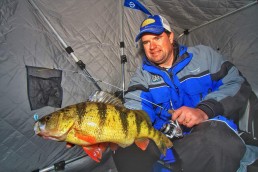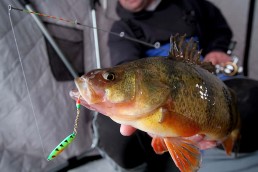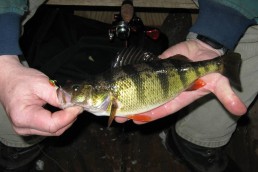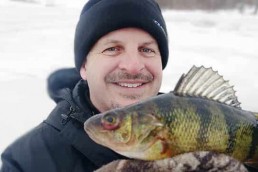Spoon-tweaking Perch
SHARE THIS POST
Few lures are as effective for jumbo perch as spoons, as they pack weight, flash and water displacement into a presentation. Spoons can be seen, and one aspect of finding fish is making sure that the fish can find you. An easy-to-find profile not only pulls fish in, but can also raise them farther off the bottom. And the higher you can lift perch, the easier they are to catch.
I find myself using some type of spoon whenever I am looking for perch or hunting down aggressive schools. Spoons can shine whenever you need to eliminate water or are in a situation where the battle is finding fish, knowing that if you can hunt these down that you will catch them.
What can make winter perch fishing challenging though is the randomness of their location and the fact that these are mobile. Perch can be found relating to some type of definite edge, but when schools roam expansive flats and basins there is the unpredictability of drilling holes in order to find them. Perch also range from aggressiveness and recklessness to demanding finesse. While tough bites can demand small tungsten jig profiles or even deadstick presentations, many bites can be discovered and maximized by using the spoons.
Deep-water exploration
Spoons shine over deep water for a variety of reasons. Deep water is often darker, so the larger profiles and the flash of a spoon can be seen farther away. Most of the time in water deeper than 20 feet I use a lead spoon that drops fast to maximize my fishing time and drops straight down without swaying to the edge of the cone angle. Then, I can watch the spoon on my electronics through the entire descent. The Clam Tackle Speed Spoon was designed specifically for this application, as it drops through the water fast and straight down without any drift. It features a short dropper chain, which is deadly for combining a little bit of finesse to the presentation. On hotter bites, replace the chain with a treble hook. I find my batting average is better if I use a treble hook whenever tipping with anything that has bulk, like a minnow head, perch eye (where legal) or a Maki Mino XL.
Besides adding some weight for pounding the mud along with profile and flash, a spoon also essentially works as a delivery system for your bait, whether using soft plastics, euro larvae, a minnow or other live bait. With that being said, I often find myself changing hooks on the spoon to maximize the efficiency of the presentation. When finesse requires waxworms or euro larvae, I often stick with the chain dropper but switch the hooks when I can. I have the mentality that I am going to use the largest hook I can get away with because when you hook a fish on a larger hook you can reel it up faster and put more leverage on the fish and also unhook it faster.
Another deep-water spoon tactic we pioneered many years ago is a method we call “bottom- dragging,” which excels whenever fish are keying on invertebrates in the mud. If you catch perch that have mud in their gills or have really pink gills and scales on the belly, those are rubbing on the bottom. The bottom-dragging technique requires a spoon like the Clam Tackle Blade Spoon. To maximize the drift, let the spoon free fall to the side of the hole as far as possible. When the spoon hits the bottom, slowly drag it back toward the center of the hole. I find that I often do better with this technique if I tie a 6-inch dropper below the spoon. The drag has to be slow and tedious. We have seen this presentation do well on tough bites where the fish won’t accelerate toward the presentation or lift off the bottom.
Running and gunning shallow water
The nuances of finding perch changes in less than 10 feet. And flutter spoons can really shine in the clearer water. There are times when we see perch respond to a spoon as soon as it clears the bottom of a hole in really clear water. I also find myself incorporating soft plastics with a single-hook spoon much more in shallower water or when not using bait at all. Shallow-water fish are notorious for being more aggressive, so your presentation and strategy should reflect the attitude of the fish.
Are you enjoying this post?
You can be among the first to get the latest info on where to go, what to use and how to use it!
Shallow water demands even more mobility, as it seems like 90 percent can be caught in 10-percent windows—where you have to simply eliminate water and find that hot hole or two each day and can wind up on the fish. When you finally find them, you’re likely where multiple fish are stacked up below and you may literally have a fish on as soon as you get back down. The key to catching them is simply finding them and being efficient so you can catch as many as possible before you lose them.
On these torrid, shallow-water bites, I like the efficiency of a large-gap single hook. No split ring or treble hook needed; use a fixed-hook spoon where a larger hook is molded into the spoon. This single hook accomplishes a couple of things: You can load up a soft plastic or more bait on to the hook. And, the larger hook allows you to reel the fish up faster, allowing you to unhook a fish faster which speeds up your turn-around time. I will even go so far as to bend out the hook and pinch down the barb so that I can get a fish unhooked even faster. I’ll also use heavier line and a stiffer rod to crank the fish up as fast as possible to maximizing my opportunities.
One of my favorite presentations over shallow water is to horizontally rig a Maki Mino XL
onto a blade jig. We filmed an episode on Lake Winnibigoshish a few winters ago with this presentation and the number of fish you can catch on a soft plastic is staggering. Once again, you make yourself more efficient by being able to get fish unhooked faster and not having to rebait.
Additional considerations
As a general rule of thumb, we rely more on glow colors and gold over deeper water more, or whenever light penetration is less. Chromes, metallics and other realistic finishes can shine over deeper water, but color can be overrated in that there are many variables and factors that are more relevant. The most important factor though is finding the fish and being efficient with the bites and managing a school. Match the spoon profile and characteristics with the water and don’t be afraid to make additional tweaks to the hook size to maximize your efficiency on the ice.
Jason Mitchell is a top walleye guide on Devils Lake, N.D. He is the host for the outdoor program, “Jason Mitchell Outdoors.” Visit jasonmitchelloutdoors.com for more.
MWO
SHARE THIS POST
Did you enjoy this post?
You can be among the first to get the latest info on where to go, what to use and how to use it!
Jason Mitchell
Jason Mitchell was a top walleye guide on Devils Lake, N.D. for nearly 20 years. Today, Mitchell produces the Jason Mitchell Outdoors TV program. Visit jasonmitchelloutdoors.com for more.




